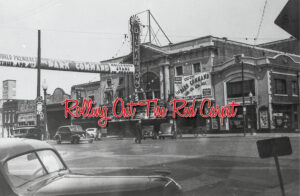| story by | |
| OPEN A PDF OF THE ARTICLE |
When settlers arrived to the Kansas Territory, they brought with them plants that soon began to populate the sparse area.

When settlers from the eastern United States first arrived in the Kansas Territory, they found a landscape that was prairie with very few trees. They brought saplings, seedlings, and shrubs to populate their new homes with familiar vegetation. It did not take long for the landscape to change to include houses, farms, trees, gardens, livestock and all the signs of a growing agricultural community. Of the five nurseries listed in the 1873 Atlas of Douglas County, those featured in this article will be W. E. Barnes, Vinland Nursery and Fruit Farm; David Kerns, farmer and fruit grower; and William Plasket, Plasket Nursery and Fruit Farm.
LOCAL MATTERS
Our Local Advertisers – Making a Positive Impact
David Kerns had the smallest business of the three. He was born in Columbiana County, Ohio, on July 19, 1821, and came to the Kansas Territory in 1859. He settled in Palmyra Township, Douglas County. The 1875 Kansas Census reported that he owned 25 acres of orchards and tended a 1-acre vineyard. He had 160 acres that were fenced and 10 that were not. His fences consisted of 160 rods of rail and 1200 rods of hedges. The cash value of his property was estimated at $3,000. In addition to his fruit production, he grew corn, oats, Irish potatoes and millet. By 1883, he owned 410 acres that had been improved and well-stocked. The home he built in 1859 cost $1,500, and the barn he built in 1868 cost $1,000. He and his wife, Susanna, had 3 sons: Yocum, Frank and Willie.
William Plasket had a more substantial operation. He was born in Clark County, Indiana, on April 10, 1824. He first moved west to Iowa in 1856, where he farmed and operated a hotel for a short time. He came to Kansas in 1869 and brought with him hedge plants, a business he had been involved in for several years. The Kansas Census for 1875 enumerated that he had 60 acres of nursery plants, 20 acres of orchards and 2 acres of vineyards. Seventy-five acres of his farm were fenced, and 3 had not been fenced. His property was valued at $1,200. Of the 160 acres that had been fenced, 60 rods of fence were rail, 260 rods were board and 600 rods were hedges. In 1882, he raised 2,000 bushels of apples. He was active in local politics. He and his wife, Martha, had six children: Robert, Emma, John, Elmer, Mattie and Maggie.
In April 1885 Plasket sold his nursery stock and moved to Lawrence to open the Douglas County Nursery. An advertisement in the Baldwin Weekly Visitor provides a description of the stock he proposed to sell.
- For sale—15,000 3-year old and 3,000 4-year-old apple trees of the best leading varieties. No. 1 trees, 3-yr-old, 5 to 6 feet high, $7.50 per hundred; 3-yr-olds, 4 to 5 feet high, $3; 4-yr-olds, 6 to 7 feet high, $7.50. If you want trees cheap now is the time to get them. Also all kinds of Nursery Stock; 50,000 hedge plants $1.50 per thousand.
- Baldwin City Nursery at Cemetery grounds
- W. Plasket
W. E. Barnes is believed to have established the first vineyard in Kansas and, ultimately, had the second-largest nursery in Kansas. William Eliot Barnes was born on Sept. 21,1832, in Dracut, Massachusetts. When he was 10 years old, he lived with a relative who taught him the nursery business. He moved to the Kansas Territory in 1856, serving with free-state supporters during the territorial conflict and in the state militia during the Civil War. He purchased 160 acres of land in Palmyra Township, Douglas County, Kansas Territory. He brought with him cuttings from Concord and Dracut Amber grapevines. Barnes was a founder of the Kansas State Horticultural Society, which was charted in 1867, and served as the first treasurer of the organization.
He quickly established the Coal Creek Nursery. An advertisement in 1865 stated that the nursery had 10,000 apple trees, 10,000 grapevines consisting of 15 different varieties, and trees and shrubs. In 1868, Barnes began a short-lived partnership with Seth Kelly, and they changed the name of the business to Vinland Nursery and Vineyard. The agricultural statistics for the 1875 Kansas State Census listed Barnes as having fenced 275 acres, and the value of the farm was $6,000. He had 60 acres of nurseries, 120 acres of orchards and 17 acres of grapevines. Barnes had 150 rods of rail fences and 970 rods of hedges. According to the 1875 census, he produced 1,200 gallons of wine in 1874. By 1883, he owned 385 acres with 175 acres planted in fruit trees and vines, including 100 acres of apple trees of various ages. He harvested over 10,000 bushels of produce in 1882. In 1887, the Lawrence Journal, reporting on a joint meeting of the horticultural societies of Douglas and Franklin County, stated, “If there is any spot on earth that can be called an Eden of Paradise, it is the beautiful umbrageous [shady]grounds of Mr. Barnes of Vinland.” The article says Barnes had 4,000 evergreens, 6,500 apple trees and 1,500 pear trees on the 400-acre farm. By 1891, the business was named the Vinland Nurseries and Fruit Farm, which was shortened to Vinland Fruit Farm by 1910.
Several of the workers at the nursery and vineyard lived on the Barnes property, as they were listed as members of the Barnes household in the 1875 Kansas Census. The members of the Barnes family included W. E., age 41, Gertrude, 30 years old, Sarah Gert, who was a 53-year-old housekeeper, and 11-year-old Florence Dunn. Others listed were workers on the farm. Most of the young men had been born in Sweden and immigrated to the U.S. Their names and ages follow: John Bensen, 24 years old; Ola Benson, 18; Aug Bleim, 18; and Charles Peterson, 13. Two other workers were Owen Jennings, 20 years old, from Ohio, and David Jones, a 24-year-old from Kentucky.
Barnes was one of the founders of the town of Vinland. In 1869, he purchased 40 acres and plated the town. In addition, he successfully lobbied the Leavenworth, Lawrence and Galveston (LL&G) Railroad to extend a line to Vinland. He donated a strip of land through his property for the right-of-way. The LL&G Railroad was part of the Atchison, Topeka and Santa Fe Railway, and this allowed Barnes to ship fruit and trees all other the country. He supported the new community by donating land for Methodist and Presbyterian churches, the Vinland Grange Hall, a one-room school, and for a high school.
Barnes had married a local woman, Gertrude Adelia Dunn, of Douglas County, in ¬¬¬1867, but they had no children. The couple was well-liked by neighborhood children because they often invited children to their home. He put a gate in the fence on the south side of his property to provide students with a short cut to school. The children referred to Barnes as Uncle B.
A building related to Barnes is listed on the National Register of Historic Places. The Barnes Apple Barn is a large limestone barn built in 1891 used to process grapes, apples and pears. The property also contains the family farmhouse, on a hill overlooking the valley. It is located at 714 E. 1728 Rd., Douglas County. It was on the 2021 Douglas County Historic Sites Tour so visitors could tour the barn.




